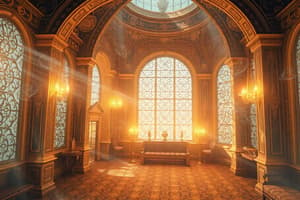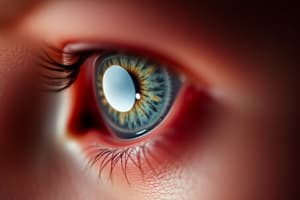Podcast
Questions and Answers
What is sensation primarily concerned with?
What is sensation primarily concerned with?
- The organization of past experiences.
- The influence of group perceptions.
- The detection of physical energy from objects. (correct)
- The interpretation of sensory information.
Which statement best describes perception?
Which statement best describes perception?
- It is solely based on physiological responses to stimuli.
- It is completely objective and the same for everyone.
- It always leads to a correct understanding of the environment.
- It involves organizing sensory information based on personal experiences. (correct)
What does Weber's law suggest about the just noticeable difference (JND)?
What does Weber's law suggest about the just noticeable difference (JND)?
- It is constant across all types of stimuli.
- It is a fixed amount, regardless of stimulus intensity.
- It is larger for stronger stimuli than for weaker stimuli.
- It is a constant proportion of the original intensity of the stimulus. (correct)
Which concept relates to the smallest detectable level of a stimulus?
Which concept relates to the smallest detectable level of a stimulus?
Which of the following best illustrates the concept of psychophysics?
Which of the following best illustrates the concept of psychophysics?
What is the primary function of depth perception?
What is the primary function of depth perception?
Which of the following is NOT one of the Gestalt Laws of Perceptual Grouping?
Which of the following is NOT one of the Gestalt Laws of Perceptual Grouping?
What principle implies that nearby objects tend to be perceived as belonging to the same group?
What principle implies that nearby objects tend to be perceived as belonging to the same group?
Which process involves binding various features together to recognize an object?
Which process involves binding various features together to recognize an object?
In the context of recognizing an object, what does abstraction do?
In the context of recognizing an object, what does abstraction do?
Which of the following factors is commonly involved in determining figure-ground distinction?
Which of the following factors is commonly involved in determining figure-ground distinction?
What is necessary for the recognition of an object after its features have been acquired?
What is necessary for the recognition of an object after its features have been acquired?
What is transduction in the context of perception?
What is transduction in the context of perception?
Which function of perception determines where objects are located in space?
Which function of perception determines where objects are located in space?
What type of stimulus is represented on the sensory apparatus, such as the retina?
What type of stimulus is represented on the sensory apparatus, such as the retina?
Which of the following is NOT one of the five major functions of perception?
Which of the following is NOT one of the five major functions of perception?
What is meant by perceptual constancy?
What is meant by perceptual constancy?
Which component is responsible for determining if we should continue attending to specific information?
Which component is responsible for determining if we should continue attending to specific information?
How do we recognize objects according to the functions of perception?
How do we recognize objects according to the functions of perception?
What concept explains our ability to feel the wing of a bee dropped from close proximity?
What concept explains our ability to feel the wing of a bee dropped from close proximity?
Flashcards
Sensation
Sensation
The process of detecting physical energy emitted or reflected by physical objects, which stimulates receptors in the sense organs. It's the initial step in how we perceive things.
Perception
Perception
The process of organizing and interpreting sensory information to give meaning to our environment. It allows us to understand what we're sensing.
Psychophysics
Psychophysics
The scientific study of the relationship between physical stimuli and sensory experiences. It explores how we perceive the world around us.
Absolute Threshold
Absolute Threshold
Signup and view all the flashcards
Difference Threshold (JND)
Difference Threshold (JND)
Signup and view all the flashcards
Depth Perception
Depth Perception
Signup and view all the flashcards
Monocular Depth Cues
Monocular Depth Cues
Signup and view all the flashcards
Binocular Depth Cues
Binocular Depth Cues
Signup and view all the flashcards
Perceptual Grouping
Perceptual Grouping
Signup and view all the flashcards
Gestalt Laws of Perceptual Grouping
Gestalt Laws of Perceptual Grouping
Signup and view all the flashcards
Recognition
Recognition
Signup and view all the flashcards
Abstraction (in Perception)
Abstraction (in Perception)
Signup and view all the flashcards
Transduction
Transduction
Signup and view all the flashcards
Coding
Coding
Signup and view all the flashcards
Distal Stimulus
Distal Stimulus
Signup and view all the flashcards
Proximal Stimulus
Proximal Stimulus
Signup and view all the flashcards
Attention
Attention
Signup and view all the flashcards
Localization
Localization
Signup and view all the flashcards
Perceptual Constancy
Perceptual Constancy
Signup and view all the flashcards
Study Notes
Sensation and Perception Overview
- Sensation is the detection of physical energy emitted or reflected by objects. External energy stimulates receptors in sense organs
- Perception is the process by which individuals organize and interpret sensory information to give meaning to their environment.
- Perceptions differ from person to person. Each individual perceives the same situation differently
- Group perceptions can influence an individual's perception
- Past experiences and important values influence how individuals organize and interpret sensory information.
Psychophysics
- Psychophysics is the branch of psychology that studies the effects of physical stimuli on sensory perceptions and mental states.
- Gustav Fechner (1801-1887) is credited with founding the scientific study of psychophysics. Their research focused on studying the relationship between the strength of stimuli and a person's ability to detect the stimulus.
- Absolute threshold of sensation is the smallest amount of a stimulus that can be detected.
- The difference threshold (JND) is the smallest change in a stimulus that can be detected. Weber's Law is relevant here- the JND depends not on the size of change, but rather the proportion of the initial stimulus.
Absolute Thresholds
- The human eye can detect the equivalent of a single candle flame burning 30 miles away and can distinguish among over 300,000 different colors.
- The ear can detect sounds as low as 20 hertz and as high as 20,000 hertz. A quiet room's clock ticking 20 feet away can be heard also.
- The sense of taste can detect a teaspoon of sugar dissolved in 2 gallons of water
- Perfumes can be detected at quantities of one drop in a 3 room apartment
- The touch can feel the wing of a bee dropped from 1 centimeter
Transduction and Coding
- Transduction is the conversion of stimuli detected by receptor cells into electrical impulses that travel to the brain.
- Coding occurs when the brain transforms these electrical impulses into specific sensations.
Perception Summarized
- Stimuli such as light or sound travel to sensory receptors
- Then signal travels along neural pathways to the brain
- Based on the stimuli the brain makes sense of the stimuli leading to sensation and eventually perception.
- Both sensation and perception are needed to give meaning to the environment.
Perception: Distal and Proximal Stimuli
- Distal stimulus: external object sensed
- Proximal stimulus: representation of the distal stimulus on the sensory apparatus. (e.g., on the retina)
Functions of Perception
- Five major functions that a perceptual system performs include:
- Attention: determining which part of the sensory environment to attend to
- Localization: determining the location of objects
- Recognition: determining what the object is
- Abstracting: taking critical information from the objects
- Perceptual Constancy: maintaining a constant appearance or perception of objects despite changes in retinal images of the objects.
1. Attention
- Focused attention is a part of the perceptual experience that aids in distinguishing an object from the surroundings, keeping us alert, and focusing on task-relevant information
- Attention is a part of perceiving the environment, allowing a person to selectively focus on information and select relevant information
2. Localization
- Localizing objects involves determining their position in the up-down and left-right dimensions
- Depth perception (e.g., distance cues) and direction in which an object moves
- Locating things requires knowing how far away they are
Perceptual Grouping
- Gestalt's laws of grouping describe how parts of a scene group pre-attentively according to certain laws and principles. Factors to consider for grouping include:
- Continuity: elements that appear to form a smooth continuation are perceived as a single unit
- Proximity: elements that are close together tend to be perceived as a group
- Similarity: elements that are similar tend to be perceived as a group
- Closure: elements are perceived as a closed unit despite the interruptions
3. Recognition
- Recognition involves correctly establishing the various features of an object.
- Example: knowing an object is a loaf of bread rather than a mailbox
- Perception is pre-processed to a point where features are recognized based on context.
4. Abstraction
- Abstraction is the process of converting sensory information (like lines and shapes) into abstract categories.
- Example: converting raw sensory information to recognized forms like letters, words, or objects.
- It requires less storage space than raw information.
5. Perceptual Constancy
- Perceptual constancy allows us to perceive objects (e.g., their color, size, and shape) as remaining largely constant across variations in sensory conditions.
- Various factors like color, brightness, and size influence perception.
Studying That Suits You
Use AI to generate personalized quizzes and flashcards to suit your learning preferences.
Related Documents
Description
Explore the concepts of sensation and perception in psychology. This quiz covers the definitions, influences on perception, and the basics of psychophysics introduced by Gustav Fechner. Understand how sensory information is processed and interpreted to create individual experiences.



